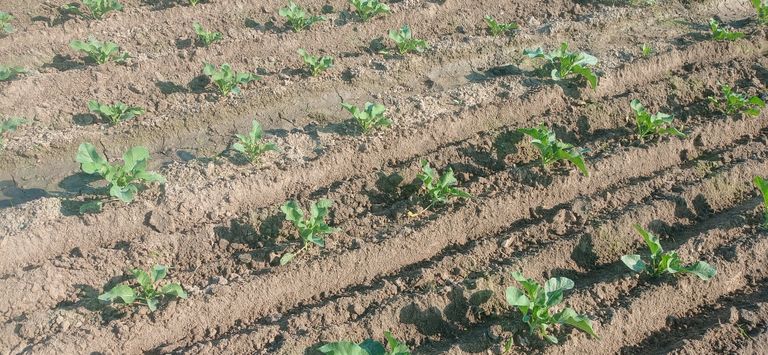Cauliflower (Brassica oleracea var. botrytis) is a cool-season vegetable that belongs to the cruciferous family. It is prized for its edible, white flower head, also known as the "curd," which is rich in essential nutrients. Cultivating cauliflower involves several key practices to ensure healthy growth and high-quality produce. Understanding its cultivation methods, along with its nutritional benefits, can help both farmers and consumers appreciate the versatility and importance of this vegetable.
Cultivation Methods of Cauliflower
Climate and Soil Requirements:
Cauliflower thrives in cool temperatures, ideally ranging from 50 to 70°F (10 to 21°C). It is sensitive to heat, and high temperatures can cause the plant to bolt or produce poor-quality heads. Therefore, it is best grown during early spring or late fall in most regions. Cauliflower prefers well-drained, fertile soils with a pH of 6.0 to 7.5. The soil should be rich in organic matter, which helps retain moisture and provides essential nutrients.



Land Preparation and Sowing:
Preparing the soil for cauliflower begins with deep tilling to break up any compacted layers, followed by incorporating compost or well-rotted manure to improve soil fertility. Seeds can be started indoors in trays or pots 6 to 8 weeks before the last expected frost, with each seed sown in a shallow hole. Once seedlings develop their second set of leaves, they can be hardened off by gradually exposing them to outdoor conditions before transplanting them into the field. Direct sowing in the field is also possible, but it requires careful timing.
Transplanting and Spacing:
When transplanting, it is essential to space the plants 18 to 24 inches apart in rows that are 24 to 36 inches apart. This spacing ensures that each plant has adequate room for growth and air circulation, reducing the risk of diseases. A well-prepared, evenly irrigated seedbed is critical for healthy establishment.



Land Preparation and Sowing:
Preparing the soil for cauliflower begins with deep tilling to break up any compacted layers, followed by incorporating compost or well-rotted manure to improve soil fertility. Seeds can be started indoors in trays or pots 6 to 8 weeks before the last expected frost, with each seed sown in a shallow hole. Once seedlings develop their second set of leaves, they can be hardened off by gradually exposing them to outdoor conditions before transplanting them into the field. Direct sowing in the field is also possible, but it requires careful timing.
Transplanting and Spacing:
When transplanting, it is essential to space the plants 18 to 24 inches apart in rows that are 24 to 36 inches apart. This spacing ensures that each plant has adequate room for growth and air circulation, reducing the risk of diseases. A well-prepared, evenly irrigated seedbed is critical for healthy establishment.



Watering and Fertilization:
Cauliflower requires consistent moisture, especially during the head formation stage. Drip irrigation or soaker hoses are often used to deliver water directly to the root zone, minimizing water loss and preventing foliar diseases. Regular fertilization with a balanced fertilizer supports vegetative growth and head development. Calcium is particularly important for cauliflower, as it helps prevent diseases like "tip burn," which is caused by calcium deficiency.
Pest and Disease Management:
Common pests that affect cauliflower include aphids, cabbage worms, and flea beetles. Integrated pest management (IPM) strategies such as using row covers, introducing natural predators, and applying organic insecticides can help control pest populations. Cauliflower is also susceptible to fungal diseases like downy mildew and black rot, which can be mitigated through proper crop rotation, spacing, and the use of disease-resistant varieties.




Harvesting:
Cauliflower is typically harvested when the curd reaches the desired size and is still compact and white. This usually occurs 7 to 12 weeks after transplanting, depending on the variety and growing conditions. Harvesting should be done carefully to avoid damaging the plant, and the curd is typically cut from the plant with a sharp knife.
Nutritional Benefits of Cauliflower
Cauliflower is a nutrient-dense vegetable that offers several health benefits. It is an excellent source of vitamins, minerals, and antioxidants, making it a valuable addition to a balanced diet.

Vitamins and Minerals:
Cauliflower is rich in vitamin C, an essential antioxidant that supports the immune system, helps in collagen production, and aids iron absorption. It also contains a significant amount of vitamin K, which is crucial for bone health and proper blood clotting. Additionally, cauliflower provides B-vitamins, particularly folate, which is important for cell division and DNA synthesis.
Fiber Content:
Cauliflower is high in dietary fiber, which promotes digestive health by supporting regular bowel movements and preventing constipation. Fiber also helps in managing blood sugar levels and reducing the risk of heart disease by lowering cholesterol levels.
Antioxidants and Phytochemicals:
Cauliflower is a rich source of antioxidants like carotenoids, flavonoids, and glucosinolates. These compounds help protect the body from oxidative stress and inflammation, which can contribute to chronic diseases such as cancer and heart disease. Glucosinolates, in particular, are sulfur-containing compounds that may have anti-cancer properties.

Low in Calories and Carbs:
Being low in calories and carbohydrates, cauliflower is an excellent choice for those looking to manage their weight or follow a low-carb diet. Its versatility allows it to be used in various dishes, such as rice, pizza crust, or mashed potatoes, as a healthy alternative to higher-calorie options.
Conclusion
Cauliflower cultivation requires attention to climate, soil, water, and pest management to ensure healthy, high-quality crops. The vegetable's versatility and ability to grow in different climates make it an important crop worldwide. In terms of nutrition, cauliflower is a powerhouse of essential vitamins, minerals, fiber, and antioxidants, contributing to overall health and well-being. Whether consumed raw, steamed, or roasted, cauliflower offers numerous health benefits that make it a valuable addition to any diet.
So far Today...
Stay Home
Thanks for Your Time Friend.
♥♥♥♥♥♥
Ok
See you Again in a New blog.
Thanks for being with me.
Plese Follow Me......
@mspbro
★★To contact me★★
Subscribe My 3speak Channel https://3speak.online/user/mspbro
Follow me Twitter https://twitter.com/mdsumonpra
Add me Facebook https://www.facebook.com/sumon.mim84